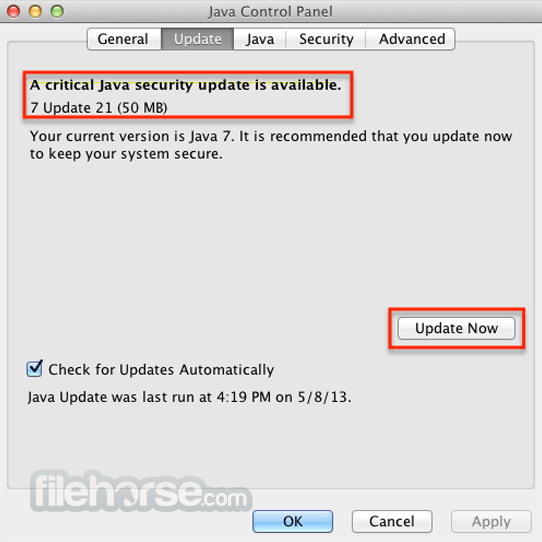Download and run that Java installer to install Java Runtime Environment 6 in modern Mac OS versions if needed. Users might need to turn off SIP protection on the Mac before being allowed to complete the installation of Java. You can also uninstall Java from a Mac if need be after the fact, or you can just disable Java too. If you want to run Java programs, but not develop them, download the Java Runtime Environment, or JRE™. Important Oracle JDK License Update The Oracle JDK License has changed for releases starting April 16, 2019. Free download Java SE Runtime Environment 8 Java SE Runtime Environment 8 for Mac OS X 👍. The Java SE Runtime Environment 8 🛠 (Java Platform, Standard Edition) is a major feature release. So you just upgraded your Mac (probably to Yosemite) and now you are getting annoying browser errors that say “To view this web content you need to install the Java Runtime Environment.” More annoyingly, after clicking through to Oracle’s Java.com to “Download Java for Mac OS X” and installing it, you still get the error! Java for OS X follows the “Write once, run anywhere” tag line of the Java runtime and this means that developers do not need to make any type of adaptations or modifications to their Java apps in order for them to run on a Mac computer. Because Java for OS X is so easy installable and the operating system.
This page describes how to install and uninstall JRE 8 on OS X computers.
Note: The JRE installation includes the JavaFX Runtime which is incorporated into the same directory structure. |
This page has these topics:
See 'JDK 8 and JRE 8 Installation Start Here' for general information about installing JDK 8 and JRE 8.
See 'OS X Platform Install FAQ' for general information about installing JRE 8 on OS X.
System Requirements
Observe these requirements:
Any Intel-based computer running OS X 10.8 (Mountain Lion) or later.
Administrator privileges.
Note that installing the JRE on OS X is performed on a system-wide basis, for all users, and administrator privileges are required. You cannot install Java for a single user.
Only one JRE can be installed at a time. The system will not install a JRE that has a lower version than the current version. If you wish to install a lower version of the JRE, uninstall the current version as described in 'Uninstalling the JRE'.

Installing a JRE from Oracle will not update java -version symlinks or add java to your path. To be able to do this, you need to install the JDK.
JRE Downloaded File
Depending on your processor, the downloaded file has one of the following names, where version is the update number:
jre-8uversion-macosx-amd64.dmgjre-8uversion-macosx-x64.dmg
Installing JRE 8u40
If you are installing JRE 8u40, then follow these steps:
Download the file.
Before the file can be downloaded, you must accept the license agreement.
From either the Downloads window of the browser, or from the file browser, double click the file
.dmgto launch it.A Finder window appears containing an icon of an open box and the name of the
.appfile.Double click the package icon to launch the Install app.
A window appears that says, 'Java 8 Update 40 is trying to install a new helper tool. Type your password to allow this.'
Enter the Administrator login name and password and then click Install Helper.
The Install app then displays the Introduction window.
Click Next.
Oracle has partnered with companies that offer various products. The installer may present you with the option to install these programs when you install Java. Specify if you want these programs installed and then click Next.
Note:
You can disable the presentation of offers during installation by specifying the--args SPONSORS=0option in the terminal command line. For example:open /Volumes/Java 8 Update 40/Java 8 Update 40.app --args SPONSORS=0An Installation Progress window is displayed. Once the software is installed, a confirmation window appears and then an applet is launched to verify the version of Java installed.
Delete the
.dmgfile if you want to save disk space.
Download Java Runtime Environment For Mac
Determining the Installed Version of the JRE
If you have not yet installed Apple's Java OS X 2012-006 update, then you are still using a version of Apple Java 6 that includes the plug-in and the Java Preferences app. See 'Note for Users of OS X that Include Apple Java 6 Plug-in'.
Only one JRE can be installed. Installing a JRE removes the previously installed JRE. The JRE version used by the system can be determined in one of two ways:
From System Preferences click the Java icon from the Other category. This launches the Java Control Panel. Click About.
Type the following in a Terminal window (note escaped space character, ignore line break):
The system will not install a JRE that has a lower version than the current version. If you want to install a lower version, first uninstall the existing version.
Download Java Se 6 Runtime For Mac Sierra
Uninstalling the JRE
To uninstall the JRE, you must have Administrator privileges and execute the remove commands either as root or by using the sudo(8) tool.
Remove one directory and one file (a symlink), as follows:
Download Java Se 6 Runtime For Mac 10.10
Navigate to
/Library/Internet Plug-Insand remove theJavaAppletPlugin.plugindirectory.Navigate to /
Library/PreferencePanesand removeJavaControlPanel.prefpane.
Java Se 6 Runtime Mac Download
Do not attempt to uninstall Java by removing the Java tools from /usr/bin. This directory is part of the system software and any changes will be reset by Apple the next time you perform an update of the OS.